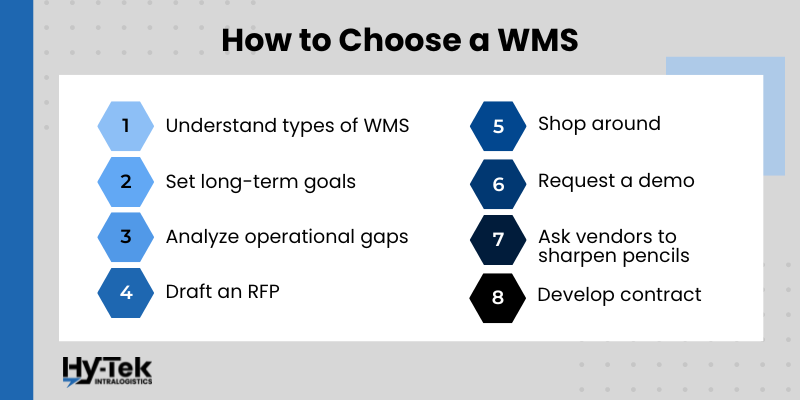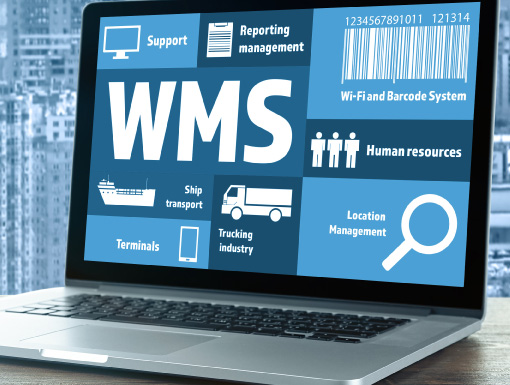When it comes time to choose a warehouse management system (WMS), making a decision can seem daunting. There are so many factors to consider, and it can be tough to know which tools to trust given the continually changing technology landscape.
In this blog post, we will walk you through the steps of how to choose a warehouse management system for your business. We will provide an overview of the different types of WMS software on the market and give you tips on how to evaluate each one.
By following these guidelines, you will be able to find the right warehouse management system for your fulfillment and distribution operation!
How to Choose a Warehouse Management System – 8 Steps
- Familiarize yourself with the types of WMS
- Understand long-term goals
- Analyze current operational gaps
- Draft a request for proposal for WMS
- Shop around
- Request a demo
- Ask vendors to sharpen their pencils
- Develop and sign a contract

Step 1: Types of WMS
The first step in choosing a WMS is to understand what is a warehouse management system, and what are the different types of WMS on the market. There are 3 main categories of warehouse management systems:
– Standalone WMS
This type of WMS is installed on a local server and is used to manage one warehouse. This can be a great option for businesses that don’t need or want the features of a larger system.
– Enterprise Resource Planning (ERP) Module WMS
This type of WMS is a Distribution Center extension module for more mature ERP systems. It can be used to manage multiple warehouses and is a potentially great option for businesses that already have an advanced ERP.
– Cloud-Based / Software-as-a-Service (Saas) WMS
This type of WMS is hosted in the cloud and can be accessed from any device with an internet connection. This is ideal for businesses that need to manage multiple warehouses and want the flexibility of being able to access their warehouse data from anywhere.
Once you understand the types of warehouse management systems, you can begin to narrow down your options.
Step 2. Understand Long-Term Goals
Before you begin the WMS selection process, it’s important to identify your company’s long-term goals. This will help guide you during the selection process so that you can make sure the WMS you choose is tailored to meet those needs.
Goals can be related to specific metrics and key performance indicators, or you may have a goal that you want to be able to process a wider variety of SKUs or have higher inventory visibility.
Step 3. Analyze Current Operational Gaps
Analyze your warehouse operations and warehouse KPI metrics. Next, figure out what tools you are missing that will help you achieve your long-term goals outlined in Step 1.
A good question to ask during this stage, is “what is standing in the way of our business reaching our growth goals?” Are you having issues with inventory visibility, customer satisfaction, order fulfillment, or labor management?
Understanding these types of operational gaps will help you better determine what areas you need the WMS to perform.
Step 4. Draft a Request for Proposal (RFP) for WMS
Compile your long-term goals and current gaps to build an RFP that you will send to WMS providers. This is your shopping list that will instantly qualify or disqualify suppliers.
What do you want to be able to accomplish in 3, 5, and 10 years, and why can’t you currently accomplish those goals with the technology that you have in place now?
Here’s a couple other questions to consider while drafting an RFP:
- Are you upgrading your current system, or are you implementing a new one?
- Do you have an Enterprise Resource Planning (ERP) system?
- What warehouse software systems does the WMS need to integrate with?
- What are your data security requirements?
- Are you looking to automate certain warehouse processes in the near future?
- What is your warehouse layout?
- What level of customizability do you require and what level of internal technical support do you have?
Featured Resource
[Free Download] WMS Questionnaire
Questions to guide you in your WMS selection process.

No strings attached. Free download.
Tip from an expert: A key part of choosing a WMS is understanding the venders’ IT systems structures and making sure that your internal IT department can support the software. It is imperative to include IT throughout the entire WMS selection process.
There are many ways that software vendors handle long-term maintenance. Some of the vendors are very hands-off with customization (i.e. hand you the keys to the software and you can customize it however you please). That’s great if you have a robust, internal IT team with the capability to customize and maintain it.
However, what we often see happen is the operations team will be the number one driver in choosing a WMS because it will fix operational problems X, Y, Z. Then, the IT team is brought into the conversation later to look at the network structure, but they do not discuss future customizations or maintenance. This results in a disconnect between operations and IT that can mean hefty maintenance costs in the future.
A good analogy would be that of a Linux computer’s operating system vs a Mac computer’s operating system – Linux OS is great for the people that know how to use it and customize it. Mac, however, is a pre-packaged solution that pushes automatic updates and is less customizable. This solution is attractive because it is easy to use.
So, do you want a Linux machine or a Mac?
Step 5. Shop Around
Send out your RFP to multiple WMS suppliers. Look at who is out there in the WMS market, what products exist, and how they would fit into your organization. Making sure the software solution will fit into your organization is the key to a successful implementation.
When shopping around, you need to ask, “Does the supplier match or provide what I need to fill the gaps.” A large issue that people face in this phase is talking to salespeople who promises the moon but can’t deliver on the product, service, or integration.
There are different tiers of WMS’s that vary in complexity and functionality, however there are some basic functions that any WMS should have.
What is truly recommended here is a 3rd-party, agnostic expert or software consultant to shop around for you. If you are budgeting a large amount of money for a new software, it may be worth it to spend a percentage of that budget upfront on a software expert that can guide you through the process. This will ensure that the product you buy will actually solve your problems.
Tip from an expert: It is important to understand the long-term cost (i.e. support costs) of ownership of each WMS.
When you are shopping around, it’s important to understand whether you are buying a Software-as-a-Service or a full suite WMS as a one-time cost – i.e. how engaged is that WMS vendor going to be 3 years from now?

If you opt for a pre-packaged solution over a custom-built solution, and you want to modify the capability in the future, you may be facing a high price tag since the customizability is limited.
Whichever option you choose, it will play a factor into the long-term cost of ownership.
Step 6. Request a Demo
You would never buy a car that you haven’t test driven, right? A WMS should be the same way.
You should request a “test drive” or “conference room pilot” before you move forward in the selection process. Have the supplier come to your site to understand and SEE your operation. There is no way they can understand your needs without seeing the operation in person.
They should have a tailor-made demo that they can bring to your site as part of the sales cycle. Have all your top choice suppliers come out and demo the software to see how it best fits you.
A demo will give you insight into how their software interprets your business and how they interpret your RFP – are they in alignment with your expectations? You will also have a better feel for their communication and customer service with how willing/ready they are to help.
If they don’t understand the RFP and aren’t asking you the right questions, then there is no way the service and solution can provide what you are looking for. If the supplier is offering a pre-packaged solution without tailoring it to your business, the solution is potentially not the best route.
Step 7. Ask Vendors to Sharpen Their Pencils
Once you have your top choices, request the vendors to sharpen their pencils. This means, the first price that you are given is probably not the lowest that they can go. Provide your top WMS suppliers a list of other companies that you are also considering, and hopefully they will give you a more competitive price.
You don’t go to the Ford dealership and take the first car the salesperson suggests – you shop around and tell the salesperson, “I saw the same car in the lot next door for $4,000 less.”
Step 8. Develop & Sign Contract
After you see the contending software solutions in person, you will have a better sense of how they will fit into your organization as well as the suppliers’ customer service.
Narrow down your options, get them to sharpen that pencil even further, and choose the WMS supplier that fills your gaps and aligns with your current and future goals.
Conclusion
The process of choosing the right WMS for your operation is a lengthy one that requires research, analysis, and consideration. It’s important to consider how well each potential supplier can fill the gaps in your current process, how well they align with your company’s long-term goals, and how much value they will provide.
Take time to investigate different options. Research how the selected WMS will integrate into your operations and maximize efficiencies. Once you have done your due diligence and narrowed down your options, do a “test drive” of the final contenders before signing the agreement and beginning implementation.
By taking these steps, you can ensure that your company is getting the best value and service from the WMS that you choose.







